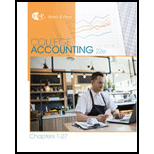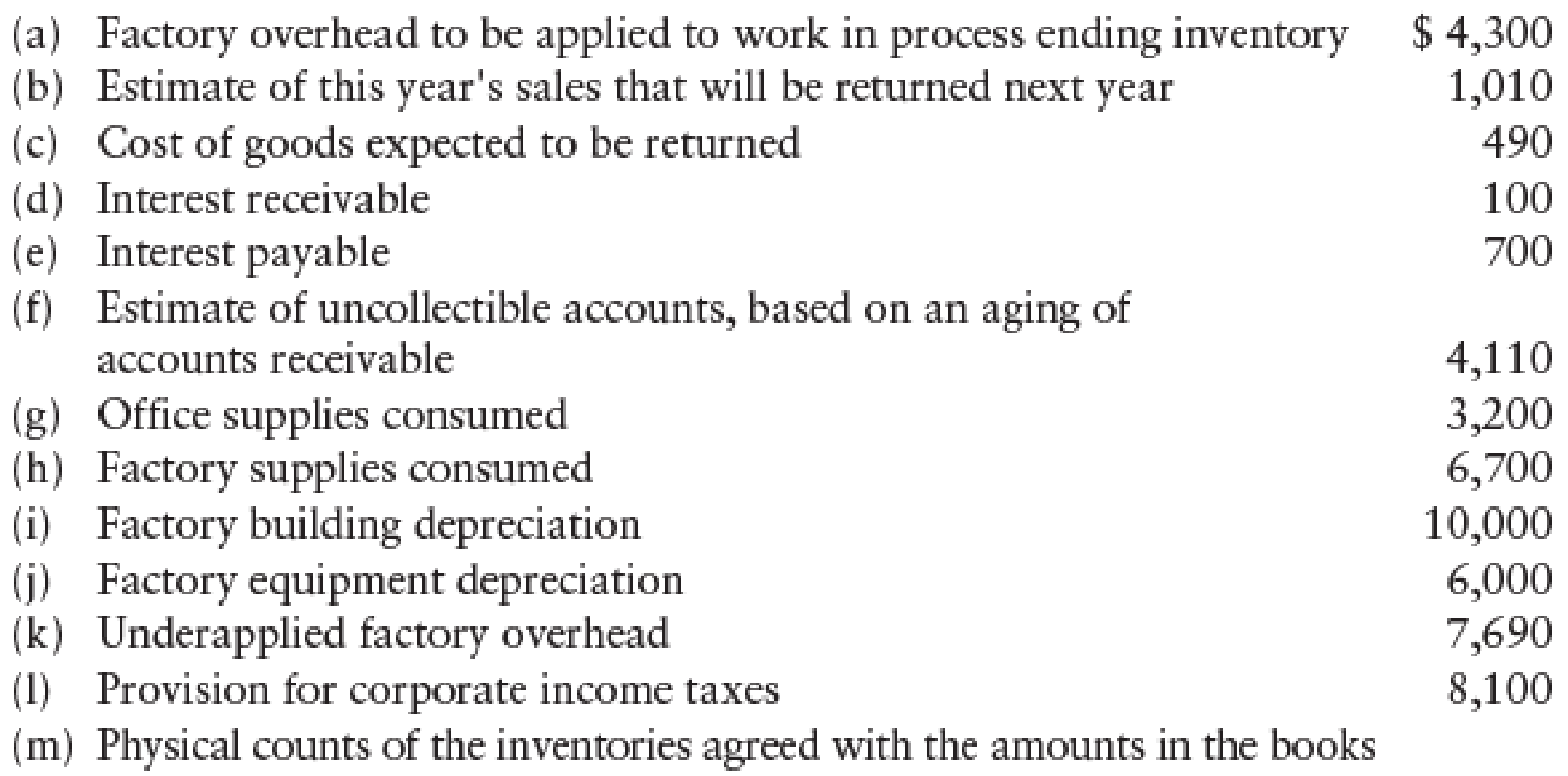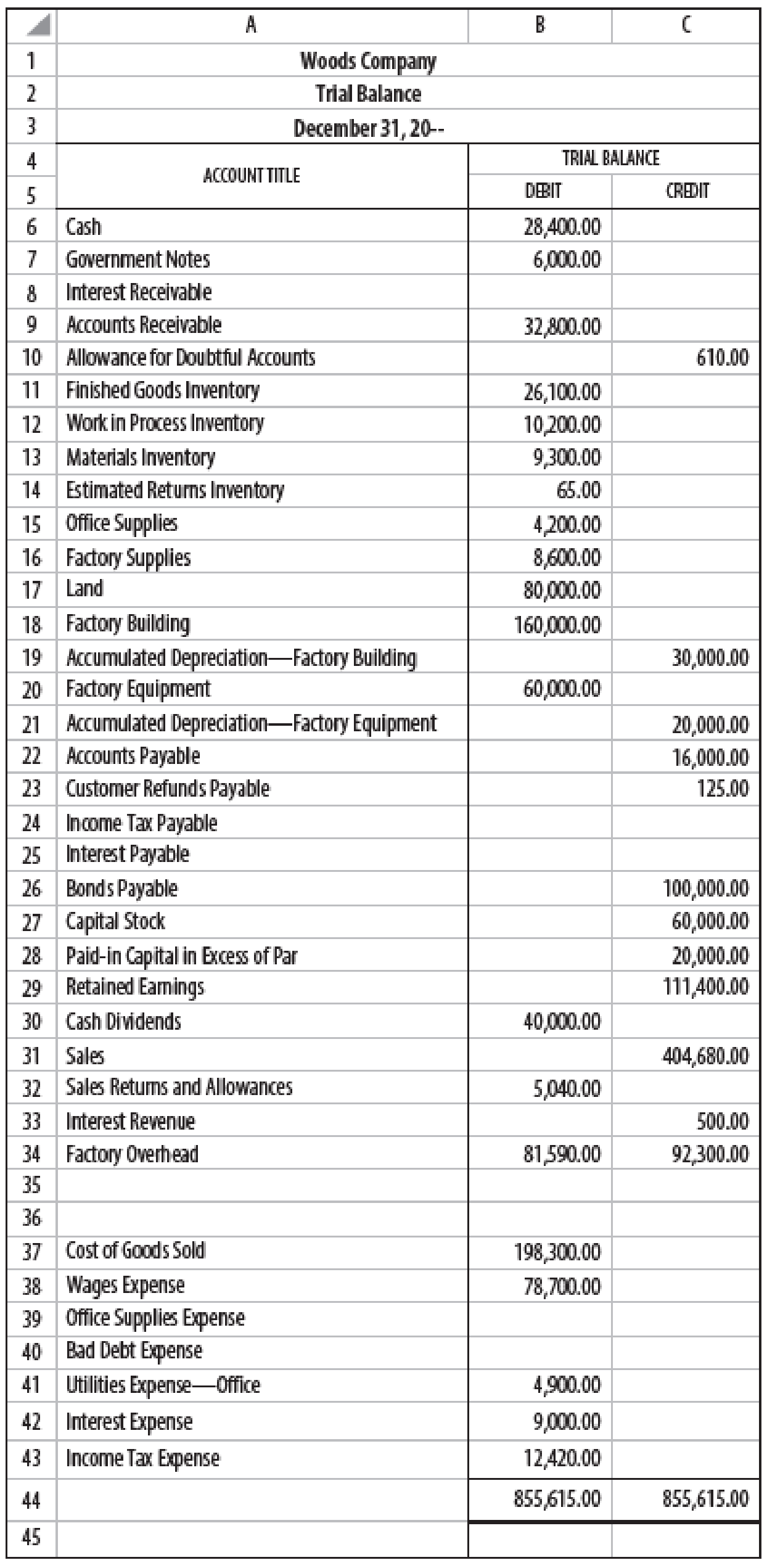
College Accounting, Chapters 1-27
23rd Edition
ISBN: 9781337794756
Author: HEINTZ, James A.
Publisher: Cengage Learning,
expand_more
expand_more
format_list_bulleted
Concept explainers
Textbook Question
Chapter 27, Problem 6SPB
SPREADSHEET,

Additional information needed to prepare the financial statements is as follows:

Assume that all materials inventory items are direct materials.
Required
- 1. Prepare a spreadsheet.
- 2. Prepare the following financial statements and schedule:
- (a) income statement
- (b) schedule of cost of goods manufactured
- (c) statement of
retained earnings - (d)
balance sheet

Expert Solution & Answer
Trending nowThis is a popular solution!

Students have asked these similar questions
Prepare T-accounts for each inventory account, Manufacturing Overhead, and Cost of Goods Sold. Post relevant data from your journal entries to these T-accounts (don’t forget to enter the beginning balances in your inventory accounts).
Prepare an income statement. All of the information needed for the income statement is available in the journal entries and T-accounts you have prepared.
Instructions:
a. Prepare the cost flow assumption table for Hasellhouf Company's merchandise inventory using FIFO method (2 decimals rounding).
b. Journalize the transactions above using perpetual method and make the
necessary adjustments and make the necessary adjustments for depreciation
(using the straight-line method), insurance, supplies, and interests
c. Post all the entries to the general ledgers.
d. Prepare multiple-step income statement, owner's equity statement, and balance sheet.
e. Journalize the closing entries.
Prepare T-accounts for inventories, Manufacturing Overhead, and Cost of Goods Sold. Post relevant data from your journal entries to these T-accounts (don’t forget to enter the opening balances in your inventory accounts). Compute an ending balance in each account.
Chapter 27 Solutions
College Accounting, Chapters 1-27
Ch. 27 - Under the perpetual inventory system, Cost of...Ch. 27 - Prob. 2TFCh. 27 - On the spreadsheet, the factory overhead account...Ch. 27 - Prob. 4TFCh. 27 - The adjustment for factory overhead applied to...Ch. 27 - LO2 The adjustment for the amount of factory...Ch. 27 - The adjustment for depreciation expense for the...Ch. 27 - At the end of the accounting period, a credit...Ch. 27 - Prob. 4MCCh. 27 - Prob. 5MC
Ch. 27 - LO2 Prepare adjusting entries at December 31 for J...Ch. 27 - Prob. 2CECh. 27 - Prob. 3CECh. 27 - Prob. 1RQCh. 27 - Prob. 2RQCh. 27 - Prob. 3RQCh. 27 - Prob. 4RQCh. 27 - Prob. 5RQCh. 27 - What are the distinctive features of ToyJoys...Ch. 27 - Prob. 7RQCh. 27 - Prob. 8RQCh. 27 - Prob. 9RQCh. 27 - ADJUSTING ENTRIES INCLUDING ADJUSTMENT FOR...Ch. 27 - Prob. 2SEACh. 27 - Prob. 3SEACh. 27 - CLOSING JOURNAL ENTRIES Prepare closing journal...Ch. 27 - REVERSING JOURNAL ENTRIES Prepare reversing...Ch. 27 - SPRE ADSHEET, ADJUSTING ENTRIES, AND FIN ANCIAL...Ch. 27 - FINANCIAL STATEMENTS The adjusted trial balance...Ch. 27 - ADJUSTING. CLOSING. AND REVERSING ENTRIES A...Ch. 27 - ADJUSTING ENTRIES INCLUDING ADJUSTMENT FOR...Ch. 27 - Prob. 2SEBCh. 27 - ADJUSTING JOURNAL ENTRIES FOR A MANUFACTURING...Ch. 27 - Prob. 4SEBCh. 27 - REVERSING ENTRIES Prepare reversing journal...Ch. 27 - SPREADSHEET, ADJUSTING ENTRIES, AND FINANCIAL...Ch. 27 - FINANCIAL STATEMENTS The adjusted trial balance...Ch. 27 - Prob. 8SPBCh. 27 - Prob. 1MYWCh. 27 - Reese Manufacturing Company manufactures and sells...Ch. 27 - Drafts of the condensed income statement and...
Knowledge Booster
Learn more about
Need a deep-dive on the concept behind this application? Look no further. Learn more about this topic, accounting and related others by exploring similar questions and additional content below.Similar questions
- Based on the partial trial balance below, prepare the Statement of Income (SCI) with supporting notes to the financial statements Make sure that the Statement of Income has the following: Net Purchases- X,XXX,XXX. Total Gross Income- X,XXX,XXX. Total Marketing and Selling Expenses- XXX,XXX. Total General and Administrative Expenses- XXX,XXX. Total Manufaturing Cost - X,XXX,XXX. Total Cost of Goods Sold- X,XXX,XXX. Total Cost of Goods Manufactured- X,XXX,XXX. Total Factory Overhead- X,XXX,XXX Net Income After Tax- XXX,XXX.arrow_forwardSuperior Company provided the following data for the year ended December 31 (all raw materials are used in production as direct materials): Selling expenses Purchases of raw materials $ 213,000 $ 260,000 Direct labor Administrative expenses Manufacturing overhead applied to work in process Actual manufacturing overhead cost $ 158,000 $ 370,000 $ 354,000 Inventory balances at the beginning and end of the year were as follows: Beginning $ 59,000 Ending $ 31,000 $ 25,000 Raw materials Work in process Finished goods ? $ 37,000 The total manufacturing costs added to production for the year were $670,000; the cost of goods available for sale totaled $720,000 the unadjusted cost of goods sold totaled $661,000; and the net operating income was $37,000. The company's underapplied or overapplied overhead is closed to Cost of Goods Sold. Required: Prepare schedules of cost of goods manufactured and cost of goods sold and an income statement. (Hint: Prepare the income statement and schedule of…arrow_forwardPlease help with this question that is attached Required: a. Prepare journal entries to record these transactions. b. Prepare T-accounts to show the flow of costs during the period from Materials Inventory through Cost of Goods Sold.arrow_forward
- Required: 1. Prepare journal entries to record the transactions given above. (Do not round intermediate calculations. If no entry is required for a transaction/event, select "No journal entry required" in the first account field.) 2. Prepare T-accounts for inventories, Manufacturing Overhead, and Cost of Goods Sold. Post relevant data from your journal entries to these T-accounts (don’t forget to enter the opening balances in your inventory accounts). Compute an ending balance in each account. 3. Prepare a journal entry to properly dispose of any balance in the Manufacturing Overhead account. (Round your percentages and final answers to 2 decimal places. If no entry is required for a transaction/event, select "No journal entry required" in the first account field.) 4. Prepare an income statement for the year. (Do not round intermediate calculations and round your final answers to nearest whole dollar amount.)arrow_forwardAfter the physical inventory is completed, the unit costs are determined by dividing the quantities on the inventory summary sheets by the total inventory costs. financial statements are prepared. accuracy of the inventory summary sheets is checked by the person listing the quantities on the sheets. quantities are entered into various general ledger inventory accounts.arrow_forwardPrepare a proper title for the annual schedule of cost of goods manufactured of Google. Does the date match the balance sheet or income statement Why?arrow_forward
- A. Prepare journal entries to record the transactions. B. Prepare T-accounts to show the flow of costs during the period from Material Inventory throughly Cost of Goods sold.arrow_forwarda. Prepare journal entries to record the transactions. b. Prepare T-accounts to show the flow of costs during the period from Materials Inventory through Cost of Goods sold.arrow_forwardAn incomplete subsidiary ledger of materials inventory for May is as follows: See Attachment a. Complete the materials issuances and balances for the materials subsidiary ledger under FIFO.b. Determine the materials inventory balance at the end of May.c. Journalize the summary entry to transfer materials to work in process.d. Explain how the materials ledger might be used as an aid in maintaininginventory quantities on hand.arrow_forward
- Info in images 2. Post your entries to T-accounts. (Don’t forget to enter the beginning inventory balances above.) Accounts Receivable Sales Beg. Bal. Beg. Bal. End. Bal. End. Bal. Raw Materials Cost of Goods Sold Beg. Bal. Beg. Bal. End. Bal. End. Bal. Work in Process Manufacturing Overhead Beg. Bal. Beg. Bal. End. Bal. End. Bal. Finished Goods Advertising Expense Beg. Bal. Beg. Bal. End. Bal. End. Bal. Accumulated Depreciation Utilities Expense Beg. Bal. Beg. Bal. End. Bal. End. Bal. Accounts Payable Salaries Expense Beg. Bal.…arrow_forwardPlease help with the following question and refer to data tables to answer part a, b, c, d, e, and f: Also, Present the journal entry for (f) cost of goods sold.arrow_forwardK Lean Accounting Vintage Audio Inc. manufactures audio speakers. Each speaker requires $111 per unit of direct materials. The speaker manufacturing assembly cell includes the following estimated costs for the period: Speaker assembly cell, estimated costs: Labor Depreciation Supplies Power $45,660 6,120 2,230 1,670 $55,680 Total cell costs for the period The operating plan calls for 160 operating hours for the period. Each speaker requires 15 minutes of cell process time. The unit selling price for each speaker is $301. During the period, the following transactions occurred: 1. Purchased materials to produce 380 speaker units. 2. Applied conversion costs to production of 360 speaker units. 3. Completed and transferred 345 speaker units to finished goods. 4. Sold 330 speaker units. There were no inventories at the beginning of the period.arrow_forward
arrow_back_ios
SEE MORE QUESTIONS
arrow_forward_ios
Recommended textbooks for you
 College Accounting, Chapters 1-27 (New in Account...AccountingISBN:9781305666160Author:James A. Heintz, Robert W. ParryPublisher:Cengage LearningCentury 21 Accounting Multicolumn JournalAccountingISBN:9781337679503Author:GilbertsonPublisher:Cengage
College Accounting, Chapters 1-27 (New in Account...AccountingISBN:9781305666160Author:James A. Heintz, Robert W. ParryPublisher:Cengage LearningCentury 21 Accounting Multicolumn JournalAccountingISBN:9781337679503Author:GilbertsonPublisher:Cengage Principles of Cost AccountingAccountingISBN:9781305087408Author:Edward J. Vanderbeck, Maria R. MitchellPublisher:Cengage Learning
Principles of Cost AccountingAccountingISBN:9781305087408Author:Edward J. Vanderbeck, Maria R. MitchellPublisher:Cengage Learning College Accounting (Book Only): A Career ApproachAccountingISBN:9781337280570Author:Scott, Cathy J.Publisher:South-Western College PubPrinciples of Accounting Volume 1AccountingISBN:9781947172685Author:OpenStaxPublisher:OpenStax College
College Accounting (Book Only): A Career ApproachAccountingISBN:9781337280570Author:Scott, Cathy J.Publisher:South-Western College PubPrinciples of Accounting Volume 1AccountingISBN:9781947172685Author:OpenStaxPublisher:OpenStax College

College Accounting, Chapters 1-27 (New in Account...
Accounting
ISBN:9781305666160
Author:James A. Heintz, Robert W. Parry
Publisher:Cengage Learning

Century 21 Accounting Multicolumn Journal
Accounting
ISBN:9781337679503
Author:Gilbertson
Publisher:Cengage

Principles of Cost Accounting
Accounting
ISBN:9781305087408
Author:Edward J. Vanderbeck, Maria R. Mitchell
Publisher:Cengage Learning

College Accounting (Book Only): A Career Approach
Accounting
ISBN:9781337280570
Author:Scott, Cathy J.
Publisher:South-Western College Pub


Principles of Accounting Volume 1
Accounting
ISBN:9781947172685
Author:OpenStax
Publisher:OpenStax College
The accounting cycle; Author: Alanis Business academy;https://www.youtube.com/watch?v=XTspj8CtzPk;License: Standard YouTube License, CC-BY